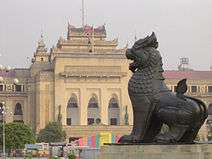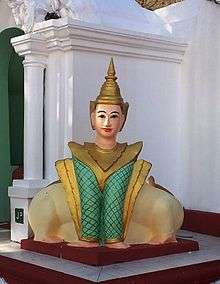Chinthe

The Chinthe (Burmese: ခြင်္သေ့; MLCTS: hkrang se., IPA: [tɕʰɪ̀ɴðḛ]; Mon: ဇါဒိသိုၚ်, [cɛ̀atìʔsaŋ]; Shan: သၢင်ႇသီႈ, [sàːŋ si]) is a leogryph (lion-like creature) that is often seen at the entrances of pagodas and temples in Burma, Cambodia, Laos and is related to the Singha (สิงห์) in Thailand and the Simha (සිංහ) in Sri Lanka as well as to other similar lion statues in other parts of Asia. The chinthe and the simha are featured prominently on the Burmese kyat and the Sri Lankan rupee respectively. The chinthe is almost always depicted in pairs, and they serve to protect pagodas. They typically appear as animals, but are sometimes found with human faces.[1]
Like the komainu of Japan, shisa of Okinawa and Snow Lion of Tibet, the chinthe is a variation of the guardian lions found in China.
Pagoda guardians
.svg.png)
The story of why chinthes guard the entrances of pagodas and temples is given as such from the Mahavamsa:
A princess had a son through her marriage to a lion, but later abandoned the lion who then became enraged and set out on a road of terror throughout the lands. The son then went out to slay this terrorizing lion. The son came back home to his mother stating he slew the lion, and then found out that he killed his own father. The son later constructed a statue of the lion as a guardian of a temple to atone for his sin.[2]
The chinthe is revered and loved by the Burmese people and is used symbolically on the royal thrones of Burma. Predating the use of coins for money, brass weights cast in the shape of mythical beasts like the chinthe were commonly used to measure standard quantities of staple items.[3]
Manussiha

The manussiha (Burmese: မနုဿီဟ manothiha, Shan: မၼုၵ်ႉသီႇႁႃႉ manuk siha), a combination of Pali manussa (man) and siha (lion) is a half-lion half-man mythical creature that is symbolic of a guardian, usually found guarding the four corners of a pagoda. It has a human head and torso and lion hindquarters.[4] It is comparable to the sphinx.
Relation to Second World War Chindits
During the Second World War, the British Brigadier Orde Wingate was given command of forces charged with Long-range penetration operations behind Japanese lines in Burma. At the suggestion of Captain Aung Thin of the Burma Rifles, Wingate decided to call this force "The Chinthes" - a name which became corrupted to "The Chindits" and is as such remembered in the annals of World War II.
See also
| Wikimedia Commons has media related to Chinthe. |
References
- ↑ Shwedagon Paya, Rangoon
- ↑ "Image 5 of 20". myanmar-image.com. Archived from the original on 2017-04-11. Retrieved 2010-09-17.
- ↑ Shwechinthe Birmans
- ↑ "Archived copy". Archived from the original on 2009-02-27. Retrieved 2010-06-19.